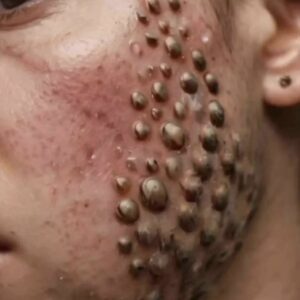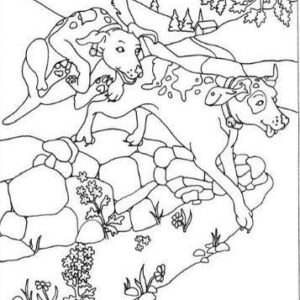The Mystery of the Tortoise Faces: A Hidden Object Illusion That Challenges Your Mind
Art has a way of making us pause, look closer, and question what we see. This captivating illustration does exactly that—it’s a surreal blend of nature and human expression, featuring a tortoise whose shell and surroundings are filled with hidden human faces. At first glance, it looks like a simple drawing of a tortoise resting among plants. But with every second you spend observing, new faces begin to appear, blending seamlessly into the creature’s body and the leaves around it.
It’s a visual puzzle, a work of art, and a meditation on perception—all rolled into one fascinating image. Let’s dive deep into the story this illustration tells and uncover the secrets hidden beneath its intricate lines.
A First Glance: The Tortoise That Holds Many Faces
At the center of the artwork sits a tortoise, its shell beautifully shaded and textured. But instead of the usual hexagonal patterns, the shell is made up of human faces—each with distinct expressions. Some look calm and thoughtful, others appear stern or melancholic. As your eyes move around the image, you start noticing even more faces—not just on the shell, but also hidden within the surrounding foliage and background.
The longer you stare, the more the image transforms. The tortoise seems to carry not just its shell, but generations of silent observers—each one watching, waiting, and reflecting. The art pulls you into its rhythm, daring you to find every hidden detail.
The Hidden Object Challenge: How Many Faces Can You Spot?
One of the most intriguing aspects of this image is its interactive nature. It’s not just something to look at—it’s something to solve.
At first, you might see five or six faces on the tortoise’s shell. Then, with sharper focus, more begin to appear on its legs, neck, and even in the patterns of the surrounding plants. The faces blend naturally into the design, each one subtly shaped by shadows, lines, and contours.
The real question is—how many can you find? Some claim to see a dozen, while others count twenty or more. Every viewer’s perception is different, and that’s what makes this illusion so endlessly fascinating.
The Symbolism Behind the Tortoise and the Faces
Beyond the hidden objects and visual challenge, the image carries a deeper meaning. The tortoise has long been a symbol of wisdom, patience, and endurance across cultures. It moves slowly but steadily, representing the passage of time and the accumulation of experience.
By combining the tortoise with human faces, the artist seems to suggest that wisdom isn’t just a trait—it’s collective. The faces could represent memories, ancestors, or the many people whose lives and stories are carried forward through time. Just like the tortoise’s shell, we each carry our pasts with us—the faces of those who shaped who we are.
It’s a poetic metaphor for life: steady, layered, and full of stories beneath the surface.
The Art of Optical Illusion: How the Mind Plays Tricks
What makes this image so captivating is how it uses pareidolia—the human tendency to find familiar shapes, especially faces, in random patterns. Our brains are wired to recognize faces instantly, even when they’re not really there.
This psychological phenomenon turns an ordinary tortoise drawing into a mesmerizing challenge. The artist cleverly uses shading, line direction, and natural symmetry to hide faces that the viewer “discovers” through focus and curiosity. The result is a piece that constantly shifts and evolves depending on how you see it.
It’s a reminder of how perception works—how our minds build meaning from what we see, sometimes creating patterns that weren’t consciously placed there.
Why We Love Hidden Object Art
Hidden object art, like this one, combines the creativity of storytelling with the thrill of discovery. It engages both the emotional and analytical sides of your brain. You’re not just admiring the art—you’re participating in it.
Every time you find a new detail, there’s a small moment of excitement, a spark of satisfaction. It’s like solving a gentle mystery. And because every person interprets visual information differently, no two people will see the exact same thing. That makes each experience unique.
This image, with its serene yet haunting mood, gives viewers the best of both worlds: the beauty of illustration and the fun of an interactive puzzle.
The Connection Between Nature and Humanity
There’s also something profound about how this artwork blends human and animal forms. The tortoise, an ancient and grounded creature, becomes a vessel for human emotion. The faces nestled within its shell almost seem to breathe, suggesting that nature and humanity are not separate, but intertwined.
The leaves and cacti surrounding the tortoise add to this connection. They, too, seem alive—each one holding subtle shapes that echo human features. It’s as if the entire ecosystem is watching us back, reminding us that every part of nature contains a reflection of ourselves.
Through this fusion of the organic and the human, the artist quietly speaks about coexistence, memory, and empathy.
How to View Hidden Object Art Like a Pro
If you want to uncover every hidden detail in this mesmerizing image, here are a few simple strategies:
Take your time. Don’t rush. Let your eyes wander slowly from one section to another.
Look at the image from different angles. Sometimes turning it slightly or viewing it from a distance reveals new shapes.
Focus on the shadows. The artist often hides faces in areas of shading or contour lines.
Relax your gaze. When you stop trying too hard, the hidden forms often appear more easily.
Compare and contrast. Some patterns repeat—spotting one might help you identify another.
The joy is in the process. The more you explore, the more you’ll uncover, making each viewing feel like a new experience.
The Emotional Impact of Discovery
Art like this goes beyond visual intrigue—it touches something deeper. Each hidden face you find feels like unlocking a secret, connecting you with the artist’s imagination. It’s almost as if these faces have been waiting patiently to be noticed, much like memories or emotions that lie beneath the surface of our own consciousness.
There’s also a sense of wonder in realizing how much can be hidden in plain sight. What else in our world might we be overlooking? What other patterns exist right before our eyes, waiting for us to slow down and see them?
Conclusion: The Layers of Time and Perception
This striking image of a tortoise filled with human faces is more than just a hidden object puzzle—it’s a meditation on observation, memory, and connection. It challenges us to look beyond the obvious, to see depth in simplicity, and to appreciate the artistry of perception itself.
Each face, each line, and each shadow tells a part of a larger story—a story about endurance, unity, and the beauty of life’s hidden layers. Whether you find ten faces or twenty, the real reward is the journey of discovery.
So the next time you come across an image like this, don’t just glance at it—immerse yourself. Look deeper. Because, just like the tortoise, true meaning takes time to reveal itself.





